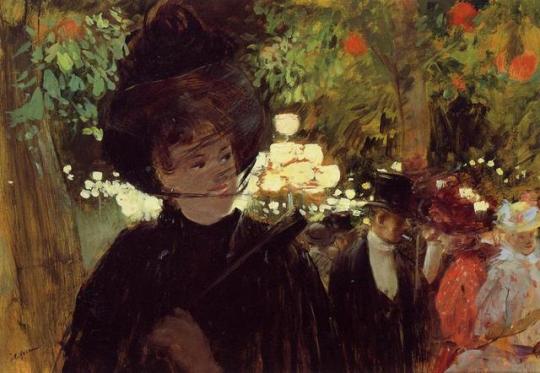Photo
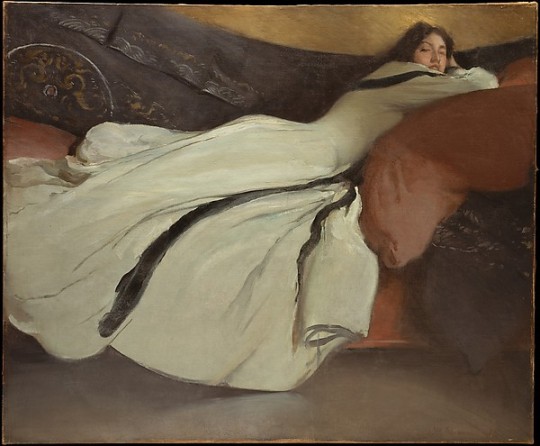
Repose
Artist: John White Alexander (American, Allegheny, Pennsylvania 1856–1915 New York)
Date: 1895
Medium: Oil on canvas
Dimensions: 52 1/4 x 63 5/8 in. (132.7 x 161.6 cm)
Classification: Paintings
Credit Line: Anonymous Gift, 1980
Accession Number: 1980.224
On view at The Met Fifth Avenue in Gallery 768
Alexander, who lived in Paris during the 1890s, achieved international success with his studies of female figures gracefully posed in elegant interiors. In this example, the provocative facial expression and supple curves reflect the contemporary French taste for sensual images of women as well as the undulating linear rhythms of Art Nouveau. With its model decoratively attired in a sweep of white fabric, "Repose" was lampooned in a French magazine as a portrayal of Loïe Fuller (1862–1928), the American dancer famous for manipulating swirling folds of silk in her performances at the Folies Bergère in Paris.
32 notes
·
View notes
Photo
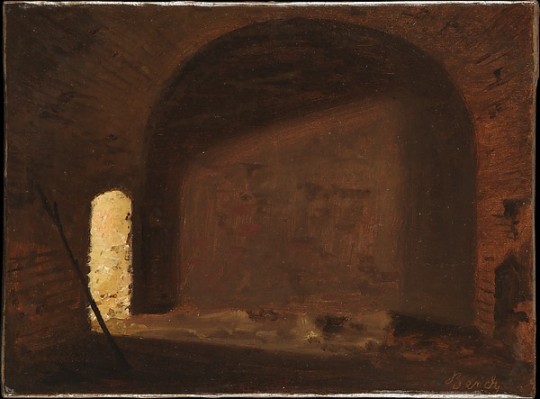
Study of Light in a Vaulted Interior
Artist: Wilhelm Bendz (Danish, Odense 1804–1832 Vicenza)
Medium: Oil on paper, laid down on canvas
Dimensions: 6 1/8 x 8 1/4 in. (15.6 x 21 cm)
Classification: Paintings
Credit Line: Thaw Collection, Jointly Owned by The Metropolitan Museum of Art and The Morgan Library & Museum, Gift of Eugene V. Thaw, 2009
Accession Number: 2009.400.3
Look real close at this one to see how wonderful it is
5 notes
·
View notes
Photo
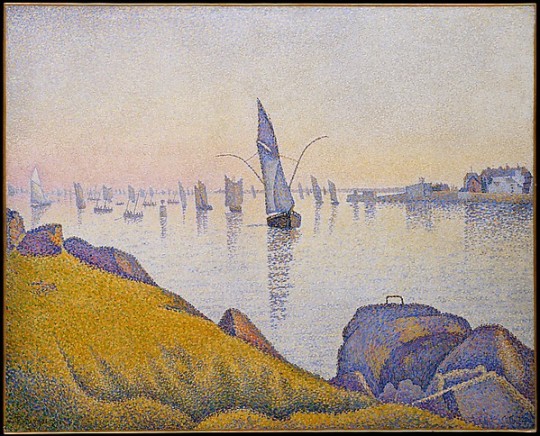
Evening Calm, Concarneau, Opus 220 (Allegro Maestoso)
Artist: Paul Signac (French, Paris 1863–1935 Paris)
Date: 1891
Medium: Oil on canvas
Dimensions: 25 1/2 x 32in. (64.8 x 81.3cm); Framed: 40 1/4 x 34 in. (102.2 x 86.4cm)
Classification: Paintings
Credit Line:
Robert Lehman Collection, 1975
Accession Number: 1975.1.209
As Georges Seurat’s most ardent follower, Paul Signac
steadfastly promoted the principles of Neo-
Impressionism all his life. Adopting Seurat’s system
of color harmony, Signac argued for the meticulous
application of precise hues in separate strokes of
paint across the canvas, a technique he said evoked
“brilliantly colored lights.” This painting is one of
five related images of fishing boats near the French
town of Concarneau, in Brittany. Signac endowed
his Concarneau paintings with musical sub-titles,
suggesting a symphonic arrangement.
2 notes
·
View notes
Photo
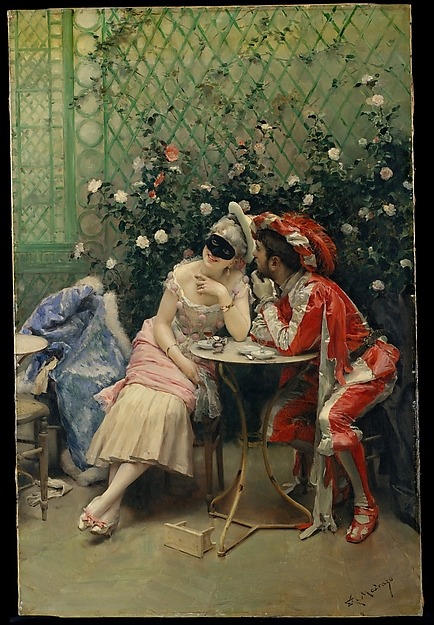
Masqueraders
Artist: Raimundo de Madrazo y Garreta (Spanish, Rome 1841–1920 Versailles)
Date: 1875–78
Medium: Oil on canvas
Dimensions: 40 x 25 1/2 in. (101.6 x 64.8 cm)
Classification: Paintings
Credit Line: Robert Lehman Collection, 1975
Accession Number: 1975.1.233
Madrazo was famous during his lifetime and painted portraits for wealthy French, American, British, and Argentine patrons. He was also known for his skillful and often flirtatious genre scenes, such as this painting in the Lehman Collection. In this scene, a couple dressed in extravagant costumes share drinks in a quiet conservatory after a ball. The male leans across the table, gazing at the coquettish blonde female whose face is hidden behind a black mask. She drapes her fingers across her chest, one of many gestures and details in the painting that Madrazo uses to evoke a playfully suggestive subject. The artist further entices the viewer with his beautiful painterly effects seen in the way that he conveys extraordinary material—satin, fur, porcelain, glass, feather, and velvet, all bathed in light.
William Henry Vanderbilt bought this painting in 1878, the same year that Madrazo won the first-class medal at the Exposition Universelle in Paris and was elected to the French Academy. This painting probably showed at the exposition in this year.
15 notes
·
View notes
Photo

The Choir of the Capuchin Church in Rome
Artist: François Marius Granet (French, Aix-en-Provence 1775–1849 Aix-en-Provence)
Date: 1814–15
Medium: Oil on canvas
Dimensions: 77 1/2 x 58 1/4 in. (196.9 x 148 cm)
Classification: Paintings
Credit Line: Gift of P. L. Everard, 1880
Accession Number: 80.5.2
Granet conceived this subject during Napoleon's occupation of Rome, at which time the Capuchin order had been banished from its seventeenth-century church near piazza Barberini. Despite French policy, the painting was purchased by the Emperor's sister Caroline Murat, Queen of Naples, for their brother Louis Bonaparte. He had seen it in Granet’s studio, where it created a sensation at the end of 1814, prompting Pope Pius VII to grant the artist an audience. This is the first version of a composition that Granet painted, by his own count, at least fifteen times.
2 notes
·
View notes
Photo
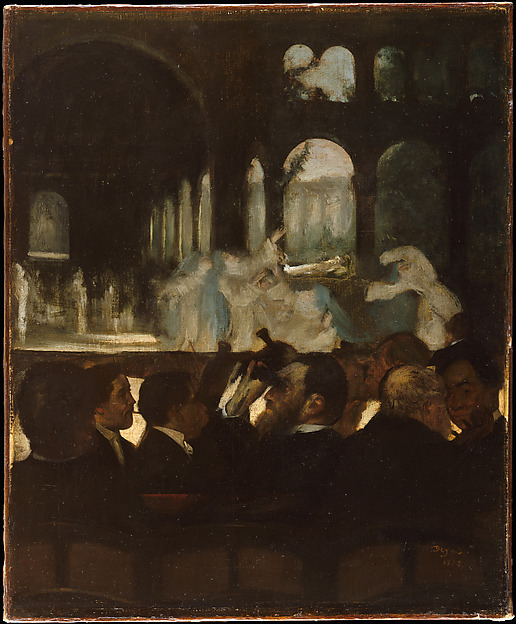
The Ballet from "Robert le Diable"
Artist: Edgar Degas (French, Paris 1834–1917 Paris)
Date: 1871
Medium: Oil on canvas
Dimensions: 26 x 21 3/8 in. (66 x 54.3 cm)
Classification: Paintings
Credit Line: H. O. Havemeyer Collection, Bequest of Mrs. H. O. Havemeyer, 1929
Accession Number: 29.100.552
“When Degas made this picture in 1871, Giacomo Meyerbeer’s opera Robert le Diable was forty years old and feeling its age—as reflected by the man at center, indifferent to the action and directing his binoculars at the audience. But Degas was fond of the opera, and particularly of the scene depicted here, from the third act, in which nuns arise from the dead and dance seductively amid the ruins of a moonlit monastery. The painting was exhibited in early 1872, the date inscribed on the canvas; Degas later executed a larger version (Victoria and Albert Museum, London) for Jean-Baptiste Faure, who starred in the opera.” - from the Met Museum’s website.
They failed to mention that Degas was a pedophile who preyed on the prepubescent girls that were usually orphans and taken in by dance schools to become ballerinas or performers. They had little to no guidance and Degas took advantage of these vulnerable young girls.
21 notes
·
View notes
Photo

Red horse, 1919, Martiros Sarian
Size: 140x104 cm
Medium: oil, canvas
38 notes
·
View notes
Photo
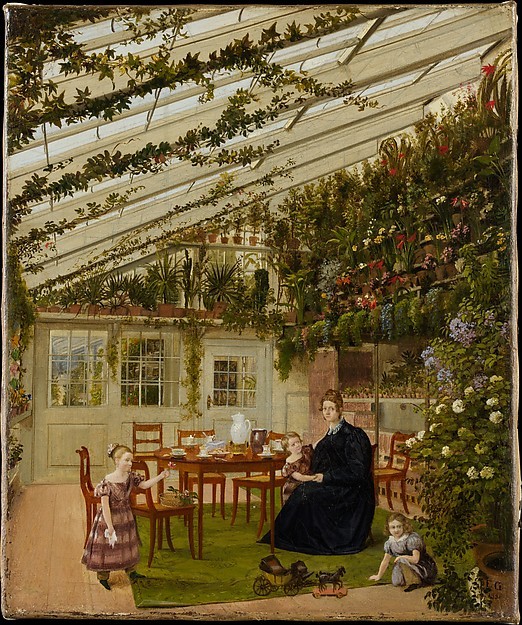
The Family of Mr. Westfal in the Conservatory
Artist: Eduard Gaertner (German, Berlin 1801–1877 Zechlin)
Date: 1836
Medium: Oil on canvas
Dimensions: 9 3/8 x 7 7/8 in. (23.8 x 20 cm)
Classification: Paintings
Credit Line: Purchase, funds from various donors, by exchange, 2007
Accession Number: 2007.70
This light-filled conservatory belonged to the prosperous Berlin wool merchant Christian Carl Westphal, a passionate horticulturist. The stark glass structure here serves as a Biedermeier day-room for his family. Gaertner was the preeminent painter of Berlin’s grand new boulevards, but this is one of only four interior scenes he is known to have painted; it may have been owned by Westfal, who was his landlord.
6 notes
·
View notes
Photo
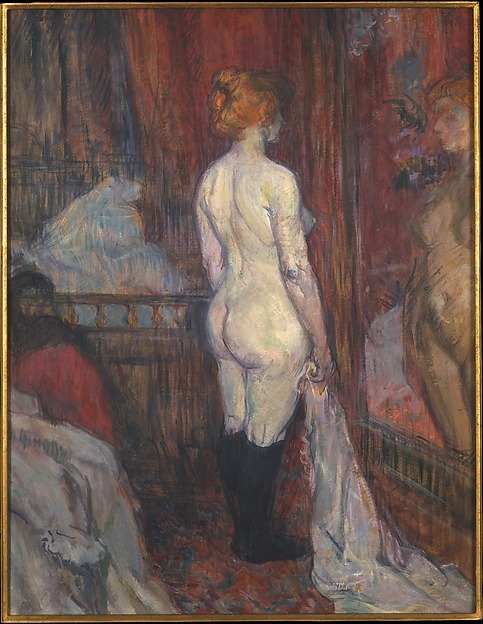
Woman before a Mirror
Artist: Henri de Toulouse-Lautrec (French, Albi 1864–1901 Saint-André-du-Bois)
Date: 1897
Medium: Oil on cardboard
Dimensions: 24 1/2 x 18 1/2 in. (62.2 x 47 cm)
Classification: Paintings
Credit Line: The Walter H. and Leonore Annenberg Collection, Bequest of Walter H. Annenberg, 2002
Accession Number: 2003.20.15
The indolent, cloistered lives of prostitutes were the subject of some of Lautrec’s most powerful works. He made about fifty paintings depicting them, as well as numerous drawings and prints, including a suite of color lithographs, Elles, which was completed the year before this painting. Lautrec does not flatter the woman’s naked figure, nor does he divulge the expression she sees in her mirror: she appears simply to be taking a stark appraisal of herself.
14 notes
·
View notes
Photo

First Steps
Artist: Franz Ludwig Catel (German, Berlin 1778–1856 Rome)
Date: ca. 1820–25
Medium: Oil on canvas
Dimensions: 18 3/4 x 14 3/4 in. (47.6 x 37.4 cm)
Classification: Paintings
Credit Line: The Whitney Collection, Promised Gift of Wheelock Whitney III, and Purchase, Gift of Mr. and Mrs. Charles S. McVeigh, by exchange, 2003
Accession Number: 2003.42.9
The theme of a child’s first steps was a popular subject of genre paintings in the uncertain years following the French Revolution, owing largely to its reassuring message of continuity. Catel, who studied at the École des Beaux-Arts in Paris, would also have been familiar with the related allegory of the Ages of Man, the subject of a major Salon painting by François Gérard (1808; Musée Condé, Chantilly). The present work shares the Italian setting of Gérard’s but updates its antique dress by depicting a contemporary peasant family.
0 notes
Photo
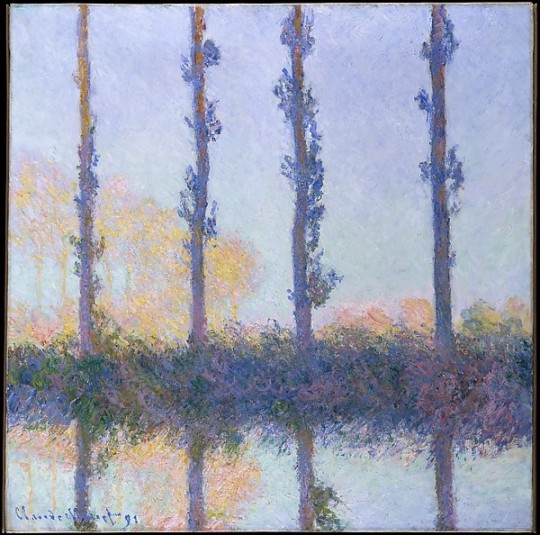
The Four Trees
Artist: Claude Monet (French, Paris 1840–1926 Giverny)
Date: 1891
Medium: Oil on canvas
Dimensions: 32 1/4 x 32 1/8 in. (81.9 x 81.6 cm)
Classification: Paintings
Credit Line: H. O. Havemeyer Collection, Bequest of Mrs. H. O. Havemeyer, 1929
Accession Number: 29.100.110
During summer and fall 1891 Monet painted a series of views of poplars along the Epte River, at Giverny. Completion of the series was temporarily threatened when the village of Limetz, across the Epte from Giverny, decided to sell the trees at auction. Monet paid a local lumber merchant to ensure that the trees remained standing until he finished his work. He painted some of the pictures from the riverbank, and others, such as this one, from a boat specially outfitted with grooves to hold multiple canvases. Like the Haystacks, the Poplars were first exhibited as a series. Fifteen were shown in Paris in 1892.
3 notes
·
View notes
Photo
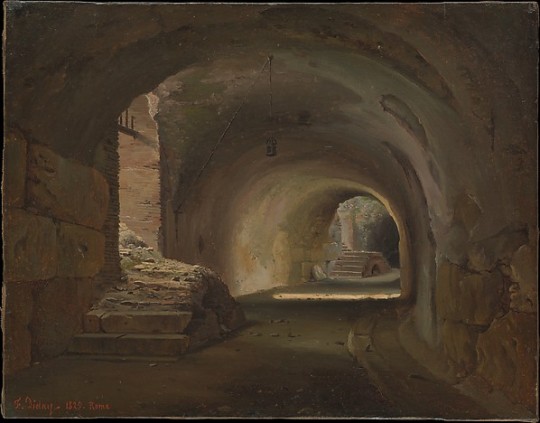
Interior Passage in the Colosseum
Artist: François Diday (Swiss, Geneva 1802–1877 Geneva)
Date: 1825
Medium: Oil on paper, laid down on canvas
Dimensions: 11 5/8 x 14 1/2 in. (29.3 x 36.9 cm)
Classification: Paintings
Credit Line: The Whitney Collection, Promised Gift of Wheelock Whitney III, and Purchase, Gift of Mr. and Mrs. Charles S. McVeigh, by exchange, 2003
Accession Number: 2003.42.24
Diday focused his attention on transitions of light and shadow in this arched passage, which was depicted by a number of artists in the early nineteenth century. The painter is said to have exhibited many studies executed in Italy following his sojourn of 1824–25. The present example may have been included in an exhibition held at Galerie Lebrun, Paris, in 1826, the year after it was painted.
3 notes
·
View notes
Photo
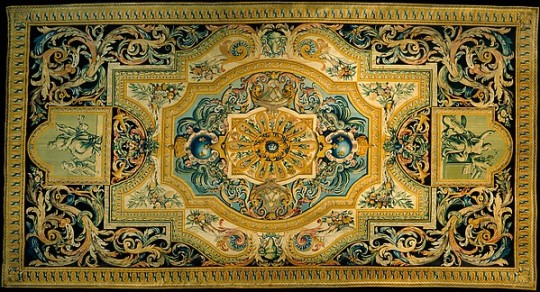
"Music"
Manufactory: Savonnerie Manufactory (Manufactory, established 1626; Manufacture Royale, established 1663)
Date: ca. 1685–97
Culture: French, Paris
Medium: Wool (Ghiordes knot, 90 knots per square in.)
Dimensions: Overall: 15' 10" x 29' 8" (356 x 190 in.) (904.2 x 482.6 cm)
Classification: Textiles-Rugs
Credit Line: Rogers Fund, 1952
Accession Number: 52.118
1 note
·
View note
Photo
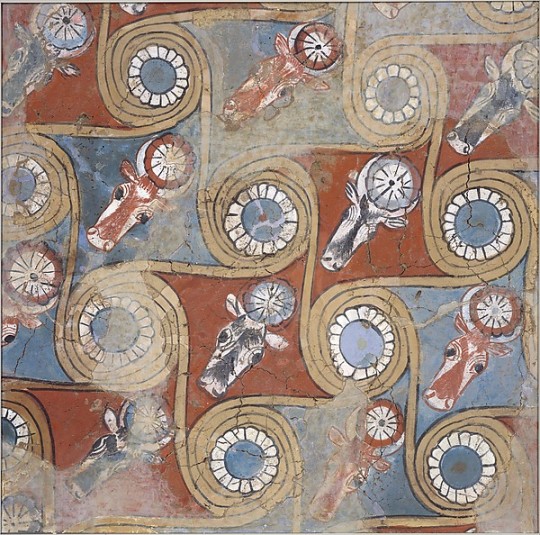
Ceiling painting from the palace of Amenhotep III
Period: New Kingdom
Dynasty: Dynasty 18
Reign: reign of Amenhotep III
Date: ca. 1390–1353 B.C.
Geography: From Egypt, Upper Egypt, Thebes, Malqata, Palace of Amenhotep III, Antechamber to King's bedroom, MMA excavations, 1910–11
Medium: Dried Mud, mud plaster, paint, Gesso
Dimensions:h. 140 cm (55 1/8 in); w. 140 cm (55 1/8 in)
Credit Line: Rogers Fund, 1911
Accession Number: 11.215.451
The important buildings in the palace complex of Amenhotep III at Malqata were embellished with floor, wall, and ceiling paintings. This partially restored section of a ceiling painting was discovered lying face up in a room adjacent to the king's bedchamber. The motif consists of a repeating pattern of rosette-filled running spirals alternating with bucrania (ox skulls). Similar ceiling patterns, both painted and modeled in plaster, have been excavated at Aegean sites of a slightly earlier period.
2 notes
·
View notes
Photo

Reading at a Table
Artist: Pablo Picasso (Spanish, Malaga 1881–1973 Mougins, France)
Date: 1934
Medium: Oil on canvas
Dimensions: 63 7/8 x 51 3/8 in. (162.2 x 130.5 cm)
Classification: Paintings
Credit Line: Bequest of Florene M. Schoenborn, in honor of William S. Lieberman, 1995
Accession Number: 1996.403.1
Rights and Reproduction:© 2018 Estate of Pablo Picasso / Artists Rights Society (ARS), New York
“In this painting of his lover Marie-Thérèse Walter reading a book, Picasso returns to a favored subject: a woman seated alone. The darkened room and glow from the lamp give her an ethereal presence, while her alabaster skin, blonde hair, and floral crown enhance her youth. Though she featured prominently in Picasso’s work at the time, their relationship was the least public of Picasso’s many amatory alliances, a fact that imbues this painting with a sense of tender intimacy. The canvas, one of several similar compositions Picasso painted of his mistress, is a poem by a man in love.” - from the Met’s website.
I would personally like to add that Picasso met Marie-Thérèse Walter when she was 17 and he was 45. They had a sexual relationship, and had children together. He was a pedophile and an abuser. This painting should not be looked at as a “painting with a sense of tender intimacy” but rather a metaphor for Picasso’s twisted desires.
2 notes
·
View notes

